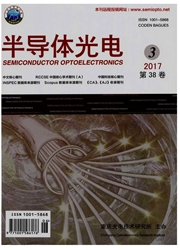

 中文摘要:
中文摘要:
低频噪声的测量和分析已成为红外探测器性能和可靠性评估的一种重要手段。制备了聚酰亚胺单层钝化和硫化后ZnS/聚酰亚胺双层钝化两种结构InGaAs探测器,测试了不同偏压或不同温度下器件的低频噪声谱,讨论了偏压和温度对InGaAs探测器低频噪声的影响。随着偏压的增加,噪声增大,拐点向低频方向移动,并且低频噪声随温度降低而减小。认为硫化后ZnS/聚酰亚胺双层钝化器件相对聚酰亚胺单层钝化器件相同偏压或温度下噪声较小,拐点低。因为硫化处理和ZnS层增强了钝化效果,器件的表面漏电流明显减小,因而大大降低了器件的低频噪声。
 英文摘要:
英文摘要:
The measurement and analysis of low frequency noise is one of the most important means to evaluate the capability and reliability of infrared detectors. Fabricated are InGaAs infrared detectors with two passivation structures with polyimide single layer or ZnS/ polyimide double layers after sulfidation treatment. The low frequency noise of InGaAs infrared detectors were measured at different bias voltages or different temperatures. The effect of bias voltage and temperature on low frequency noise is discussed. The low frequency noise increases and the knee of frequency moves towards the low frequency with higher bias voltage. The low frequency noise decreases with lower temperature. It is considered that noise and frequency knee are lower for the device with ZnS/polyimide double layers after sulfidation treatment than those of the devices with a polyimide single layer. The improvement of surface passivation process by sulfidation treatment and ZnS passivation layer, reducing surface dark current, is an effective method to reduce the low frequency noise.
 同期刊论文项目
同期刊论文项目
 同项目期刊论文
同项目期刊论文
 Suppression of extension of the photo-sensitive area for a planar-type front-illuminated InGaAs dete
Suppression of extension of the photo-sensitive area for a planar-type front-illuminated InGaAs dete Influence of thermal annealing duration of buffer layer on the crystalline quality of In0.82Ga0.18As
Influence of thermal annealing duration of buffer layer on the crystalline quality of In0.82Ga0.18As Effect of buffer layer thickness and epilayer growth temperature on crystalline quality of InAs0.9Sb
Effect of buffer layer thickness and epilayer growth temperature on crystalline quality of InAs0.9Sb Effect of buffer growth temperature on crystalline quality and optical property of In0.82Ga0.18As/In
Effect of buffer growth temperature on crystalline quality and optical property of In0.82Ga0.18As/In Effect of sulfur passivation on the InP surface prior to plasma-enhanced chemical vapor deposition o
Effect of sulfur passivation on the InP surface prior to plasma-enhanced chemical vapor deposition o Selective wet etching of Al0.7Ga0.3As layer in concentrated HCl solution for peeling off GaAs microt
Selective wet etching of Al0.7Ga0.3As layer in concentrated HCl solution for peeling off GaAs microt Investigation on growth related aspects of catalyst-free InP nanowires grown by metal organic chemic
Investigation on growth related aspects of catalyst-free InP nanowires grown by metal organic chemic 期刊信息
期刊信息
